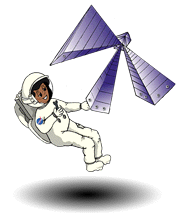![]()
 |
Wow!It takes about twelve minutes for the Space Shuttle to pass over the continental United States from California to New York. A Shuttle trip around the world takes only ninety minutes.
|
|
The Space Shuttle Columbia, the
world's first reusable spacecraft, lifted off from its launch pad in Florida on
April 12, 1981. After 36 hours and 54 minutes in space, the craft glided to a
perfect landing in California. Called "the first true aerospace
vehicle", the Space Shuttle has the ability to take off like a rocket,
orbit the Earth like a spaceship, and land on a runway like an airplane. The major components of the Space Shuttle are two solid rocket boosters (SRBs), an external tank, and a winged orbiter. The external tank is the only part which cannot be reused. The Shuttle orbiter looks like an airplane. At its forward end, or nose, is the two-level cabin built to accommodate a two-to-eight person crew. The flight deck is on the upper level. The living quarters with kitchen, toilet, and sleeping areas for off duty crew members is located below the flight deck. Behind the nose is the huge payload bay in which the Shuttle transports its cargo. Unmanned spacecraft weighing up to 25 tons can be carried into orbit. The Shuttle also has the capacity to return payloads of up to 14 tons back to Earth. This means that orbiting satellites which cannot be repaired by the crew in space can be recovered and returned to Earth for more extensive repair and another launch. |
|
|
The orbiter is the only part of the Space Shuttle which is given a name as
well as an identification number. The first orbiter built was the
Enterprise.
It was not designed for space operations but rather for tests in Earth's
atmosphere. The five operational orbiters, those designed for space operation,
were Columbia, Challenger,
Discovery,
Atlantis, and
Endeavour. The first astronaut to move
around independently in space did so from the Space Shuttle Challenger
in 1984. Unfortunately, the space program suffered a devastating loss in January of 1986 when the Space Shuttle Challenger exploded 73 seconds after launch in the skies over Cape Canaveral. The explosion was caused by a defect in the external solid rocket booster. All seven astronauts on-board were killed. Future Shuttle missions were postponed until the Shuttle program and the Shuttle design were carefully reviewed to try to insure that no further accidents occurred. In 1988, Shuttle flights resumed. The Shuttle proved its value as it carried such equipment as the Hubble Space Telescope and the Compton Gamma-Ray Observatory into orbit. Tragedy struck again on February 1, 2003 when the Space Shuttle Columbia broke apart while trying to return to Earth from orbit. Shuttle flights, using a re-designed external fuel tank, are now being flown. |
A QuestionIn what ways is the Space Shuttle able to save space program dollars? |
| Did you know? |
The Answer |
![]()
| Show me the Level 1 version of this page. |
The StarChild site is a service of the High Energy Astrophysics Science Archive Research Center (HEASARC), within the Astrophysics Science Division (ASD) at NASA/ GSFC.
StarChild Authors: The StarChild Team
StarChild Graphics & Music: Acknowledgments
StarChild Project Leader: Dr. Laura A.
Whitlock
Curator:
Responsible NASA Official: